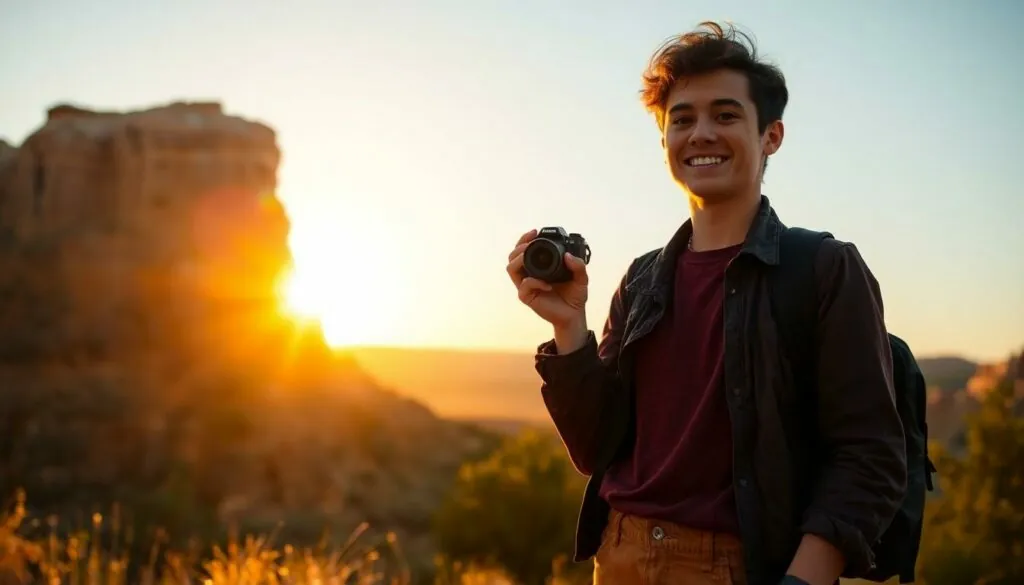Table of Contents
TogglePhotography isn’t just about pointing and shooting; it’s about capturing moments that tell a story. Whether it’s the joy of a child’s first steps or the beauty of a sunset, every click of the shutter freezes time in a way that words simply can’t. If you’ve ever wondered how to turn your snapshots into art, you’re in the right place.
What Is Photography?
Photography is the art of capturing light to create images. It combines technical skills with creativity to tell stories. Different equipment, such as cameras and lenses, allows individuals to express their unique vision. Significant moments can be frozen in time, allowing viewers to connect emotionally with the image.
Various genres exist within photography, including portrait, landscape, and street photography. Each genre focuses on different subjects and techniques, catering to diverse audience interests. Portrait photography emphasizes human connections, while landscape photography showcases the beauty of nature. Street photography captures candid moments in everyday life, revealing the world’s narratives.
The process begins with understanding the fundamentals, such as exposure, composition, and lighting. Mastering these concepts enables photographers to create compelling images. Exposure controls the amount of light reaching the camera sensor, impacting image brightness and detail. Composition involves arranging subjects within the frame to guide viewers’ eyes effectively. Good lighting enhances colors and textures, significantly influencing the photograph’s mood.
Photography can preserve memories and evoke emotions. Capturing a child’s first steps or a stunning sunset encapsulates experiences and feelings. When people view these images, they can feel the joy or serenity conveyed through the visual story. With practice, anyone can improve their skills and develop their own unique style in photography.
Ultimately, photography serves as a powerful tool for artistic expression and communication, inviting both artists and audiences into a shared visual language.
Essential Equipment for Beginners

Understanding essential equipment simplifies the entry into photography. Beginners benefit from having the right tools to enhance their skills.
Cameras
Choosing a camera starts with understanding its types. Digital single-lens reflex (DSLR) and mirrorless cameras are popular among beginners. Each type offers vast options for features and price points. When selecting a camera, pay attention to the sensor size as it influences image quality. Additionally, check for manual controls to facilitate learning and creativity. These cameras allow for adjustments in settings, providing foundational knowledge in photography.
Lenses
Lenses significantly impact a photographer’s work. Different types cater to various styles, including prime and zoom lenses. Prime lenses exhibit fixed focal lengths while offering typically sharper images. Zoom lenses provide versatility with variable focal lengths. Beginners often start with a standard kit lens, but investing in a 50mm prime lens can enhance portrait photography significantly. Understanding lens selection helps in achieving desired effects.
Accessories
Accessories can elevate the photography experience. A sturdy tripod stabilizes shots and enables long exposures under low light. Memory cards with ample storage ensure continuous shooting without interruptions. Additionally, lens filters can improve image quality and reduce reflections. Cleaning kits are essential for maintaining equipment and ensuring clarity in images. Investing in quality accessories supports developing photography skills effectively.
Basic Photography Concepts
Understanding basic photography concepts is crucial for creating impactful images. These concepts include exposure, composition, and lighting.
Exposure
Exposure determines how light or dark an image appears. Three elements control exposure: aperture, shutter speed, and ISO. Aperture adjusts the lens opening, affecting depth of field. Shutter speed controls the duration light hits the sensor, freezing motion or creating blur. ISO influences the camera’s sensitivity to light; higher values work well in low-light situations but may introduce noise. Balancing these elements is vital in achieving the desired exposure for various photography scenarios.
Composition
Composition shapes how elements within a frame are arranged. The rule of thirds encourages placing subjects along imaginary grid lines for a balanced image. Leading lines draw the viewer’s eye toward the main subject, creating depth. Framing uses elements in the environment to provide context, while symmetry creates a sense of harmony. Experimenting with different compositions fosters creativity and enhances visual storytelling, giving each photograph a unique perspective.
Lighting
Lighting plays a significant role in visual storytelling. Natural light often provides the most pleasing results at dawn or dusk, known as the golden hour. Artificial light sources, like flashes and continuous lights, can be adjusted for specific effects. Backlighting creates silhouettes and adds drama, while diffused light softens harsh shadows. Understanding light allows photographers to enhance mood and highlight important details, making images more compelling.
Photography Techniques to Master
Mastering photography techniques enhances skills and craft. Understanding and applying these principles can lead to stunning results.
Manual Settings
Manual settings allow photographers to take full control over their camera. Aperture controls depth of field by adjusting the amount of light entering the lens. Shutter speed affects motion capture, determining how quickly the camera takes a picture. ISO settings influence sensitivity to light, making images brighter or darker. Balancing these three elements is crucial for optimal exposure. Photographers often find that experimenting with different settings leads to improved understanding of their camera’s capabilities. Proficiency with manual settings enables capturing images as envisioned, transforming ordinary moments into exceptional photographs.
Focus Techniques
Focus techniques play a vital role in creating compelling images. Autofocus can simplify the process, but manual focus offers greater precision in challenging situations. Using single-point autofocus allows for pinpoint accuracy on a specific subject. Zone focusing helps with moving subjects, ensuring they remain sharp while surrounding areas blur. Depth of field manipulation influences focal plane, resulting in a pronounced foreground or background blur. Focusing on the eyes in portrait photography draws viewers’ attention and creates a connection. Mastering these techniques ensures sharp images that convey the intended mood and emotion.
Tips for Taking Stunning Photos
Photography thrives on creativity and vision. Capturing stunning images often requires attention to detail and an open mind.
Finding Inspiration
Explore various sources for inspiration, such as art, nature, and everyday life. Engaging with photography communities online can spark new ideas and perspectives. Attending exhibitions or following iconic photographers on social media also provides fresh insights. Keeping a visual journal helps to document ideas and concepts that resonate. Sometimes, simply stepping outside and observing surroundings reveals unique moments waiting to be photographed. Embrace curiosity as a driving force for creativity.
Editing Basics
Editing plays a critical role in enhancing photographs. Begin by mastering basic tools like cropping, adjusting brightness, and tweaking contrast. Understanding color correction adds vibrancy and depth to images. Experimenting with software like Adobe Lightroom or Photoshop offers advanced features for refining photographs. Learn to apply filters and presets tastefully to maintain authenticity. In addition, keeping edits subtle preserves the original storytelling aspect of each image. Prioritize enhancing rather than altering photographs to capture the intended emotion.
Photography is a journey that intertwines technical skill with artistic expression. It invites individuals to explore their creativity while capturing the world around them. By mastering the fundamentals and experimenting with various techniques, photographers can transform everyday moments into powerful visual stories.
As they delve deeper into this art form, they’ll discover the joy of preserving memories and evoking emotions through their images. With the right tools and a willingness to learn, anyone can embark on this exciting path. Whether it’s through a DSLR or a smartphone, photography offers a unique way to communicate and connect with others. Embrace the adventure and let each click of the shutter reveal a new perspective.







